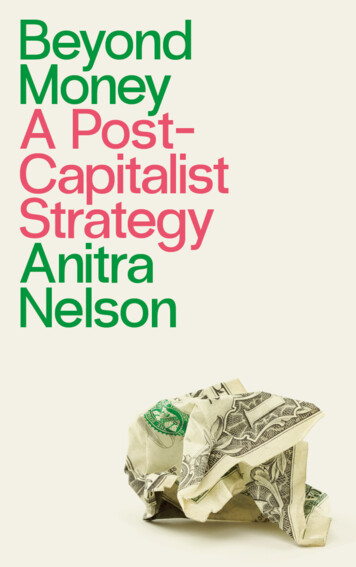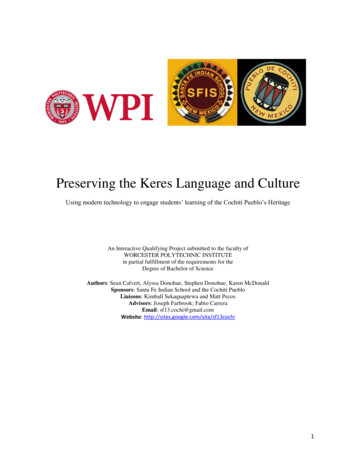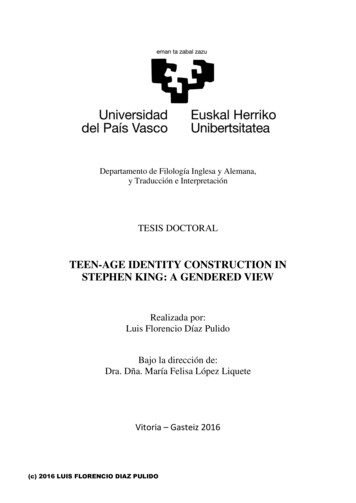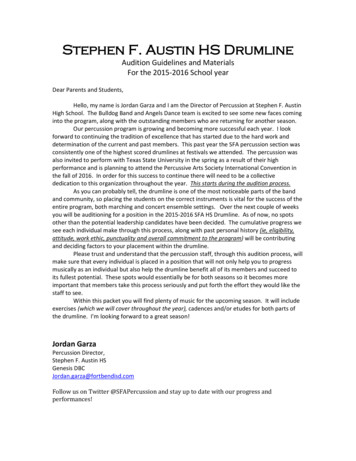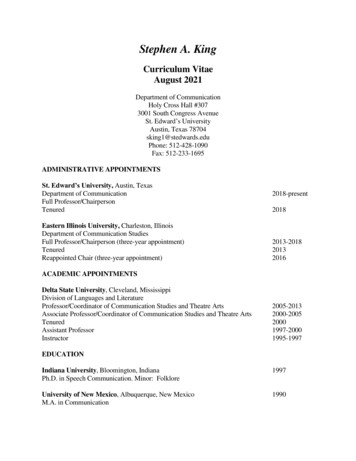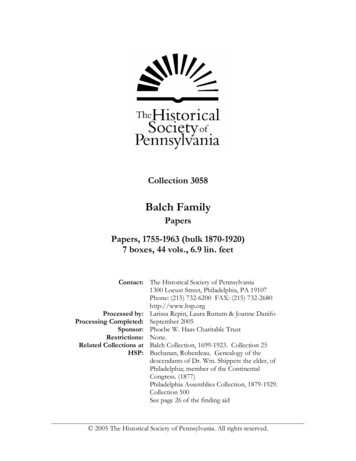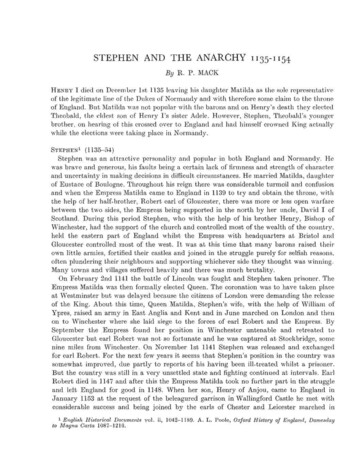
Transcription
STEPHEN AND THE ANARCHY ii35-1154By R, P. MACKI died oil December 1st 1135 leaving his daughter Matilda as the sole representativeof the legitimate line of the Dukes of Normandy and with therefore some claim to the throneof England. But Matilda was not popular with the barons and on Henry's death they electedTheobald, the eldest son of Henry I's sister Adele. However, Stephen, Theobald's youngerbrother, on hearing of this crossed over to England and had himself crowned King actuallywhile the elections were taking place in Normandy.HENRYSTEPHEN1(1135-54)Stephen was an attractive personality and popular in both England and Normandy. Hewas brave and generous, his faults being a certain lack of firmness and strength of characterand uncertainty in making decisions in difficult circumstances. He married Matilda, daughterof Eustace of Boulogne. Throughout his reign there was considerable turmoil and confusionand when the Empress Matilda came to England in 1139 to try and obtain the throne, withthe help of her half-brother, Robert earl of Gloucester, there was more or less open warfarebetween the two sides, the Empress being supported in the north by her uncle, David I ofScotland. During this period Stephen, who with the help of his brother Henry, Bishop ofWinchester, had the support of the church and controlled most of the wealth of the country,held the eastern part of England whilst the Empress with headquarters at Bristol andGloucester controlled most of the west. I t was at this time that many barons raised theirown little armies, fortified their castles and joined in the struggle purely for selfish reasons,often plundering their neighbours and supporting whichever side they thought was winning.Many towns and villages suffered heavily and there was much brutality.On February 2nd 1141 the battle of Lincoln was fought and Stephen taken prisoner. TheEmpress Matilda was then formally elected Queen. The coronation was to have taken placeat Westminster but was delayed because the citizens of London were demanding the releaseof the King. About this time, Queen Matilda, Stephen's wife, with the help of William ofYpres, raised an army in East Anglia and Kent and in June marched on London and thenon to Winchester where she laid siege to the forces of earl Robert and the Empress. BySeptember the Empress found her position in Winchester untenable and retreated toGloucester but earl Robert was not so fortunate and he was captured at Stockbridge, somenine miles from Winchester. On November 1st 1141 Stephen was released and exchangedfor earl Robert. For the next few years it seems that Stephen's position in the country wassomewhat improved, due partly to reports of his having been ill-treated whilst a prisoner.But the country was still in a very unsettled state and fighting continued at intervals. EarlRobert died in 1147 and after this the Empress Matilda took no further part in the struggleand left England for good in 1148. When her son, Henry of Anjou, came to England inJanuary 1153 at the request of the beleagured garrison in Wallingford Castle he met withconsiderable success and being joined by the earls of Chester and Leicester marched in1English Historical Documents vol. ii, 1042-1189. A. L. Poole, Oxford History of England,to Magna Carta 1087-1216,Domesday
567 S T E P H E N AND T H E ANARCHY .1135-1154triumph through the midlands. Stephen, having been defeated at Malmesbury, found therewas little he could do to stop him and when his eldest son Eustace died in October 1153 hewas no doubt glad of the opportunity for a compromise and Henry was made his successorand heir. Stephen died at Dover on October 25th 11541.In both his standard work English Coins2 and his British Museum Catalogue ('NormanKings') Brooke has divided the regular coinage of this reign into seven main types. In thefollowing pages I have adhered to Brooke's numbered classification but it is doubtful whetherthree of these types, and possibly a fourth, were in fact regular substantive issues. The systemof changing the type every three years seems to have broken down during the anarchy ofthe Civil War period and there is good evidence for supposing that the first type was notchanged until 1141. The last type (Typo 7) probably commenced about the time of thecessation of hostilities and it continued to be struck after Stephen's death in 1154 until theinception of the new coinage of Henry I I in 1158. At some time during the intervening yearsbetween 1141 and 1153 the coins classified by Brooke as Types 2, 3, 4, 5 and 6 were struck.Of these the surviving specimens of Types 3, 4 and 5 are of the greatest rarity and the mints,so far as identifiable, are confined to the East Midlands from which it seems almost certainthat these 'types' were not regular issues but should be classified as 'Local Variants'. Nocoin of the London mint is known of these three 'types' which is not surprising consideringthe poor standard of their execution and die engraving. Type 6 too is very rare but this is inall probability a substantive type. Although struck at widely separated mints these were allin royalist territory and the workmanship of the coins is good. There remains Type 2 andwhilst hesitating to suggest a run of ten to twelve years for a single type there is evidencethat this could well have been the case. However the whole period is so confusing and sowrapped in mystery, particularly in the matter of chronology, that for the present we mustbe content to wait until further evidence is forthcoming in the shape of finds or, better still,a new hoard which would throw fresh light on the intriguing and difficult coinage of the reign.In the following pages in Types 1, 2 and 7 a list of the known mints with moneyers is given,with readings. In Types 3, 4, 5 and 6 and the irregular and baronial coinage an attempt hasbeen made to produce a corpus of all the known coins. This is as complete as the writer couldmake it but there are bound to be omissions. An exception to the above is the irregular coinsof Type 1 with meaningless legends, Nos 198-205, and some of the Scottish Border coinswhen only a few representative pieces are included.In the list of coins the following abbreviations are used:—B.M.: British Museum.Nottingham: Nottingham Castle Museum.Oxford: The Ashmolean Museum, Oxford.Edinburgh: National Museum of Antiquities, Edinburgh.Cambridge: The Fitzwiiliam Museum, Cambridge.Chatsworth: The Duke of Devonshire's collection at Chatsworth, Derby.An asterisk indicates a coin is illustrated.References are as follows:—NC:Numismatic Chronicle.BNJ:British NumismaticJournal.1See also W. J . Andrew's 'A NumismaticHistory of the Reign of Stephen', BNJ, vols.vi, viii, x.2G. C. Brooke, English Coins. Revised edition,1950.
40S T E P H E N AND T H E ANARCHY h Museum Catalogue, Norman Kings, 1916.E-nglish Coins, revised edition 1950 by G. C. Brooke.The Coinage of Scotland, by E. Burns, 1887.The Scottish Coinage by I. H. Stewart, 1955.Inventory of British Coin Hoards by J . D. A. Thompson.The following are the coins of the reign.MULESTEPHENTYPE1 andHENRYITYPE15.Obv. Similar to Stephen Type 1, crowned bust to the right with sceptre in right h a n d .Rev. Similar to Henry I Type 15, quadrilateral on cross fleury.LONDON1.MINTO. R. SHEENSAXJGAR O NLVND* (o) B.M.(6) B.M.(c) Mack ex Baldwin (corroded)24-5 g.21-4 g.2T2 g.Five of these coins have been recorded, all from the the same dies 1 , but two cannot nowbe traced. They are made of copper plated with silver and are contemporary forgeries 2 .Information concerning the provenance of the B.M. coins was destroyed by enemy actionduring the war.MULEHENRYITYPE15 a n dSTEPHENTYPE1.Obv. Similar to Henry I Type 15.Rev. Similar to Stephen Type 1.2.O. HENRICVSR. Illegible* B.M. Erom the South K y m efind22-1 g.1 (c.1135 to c.1141).Obverse. Bust of the King to the right, crowned and diademed and holding in his righthand a sceptre in front of his face. The inscription, which reads either S T I E E N E , S T I E F N ER E X , S T I E F N E R , S T I E F N E R E , S T I F N E , S T I F N E R , S T I F N R E X , S T E F A N V S R , is placed around,generally divided by beaded inner and outer circles. The inner circle, which is normallyonly partial, is omitted on quite a number of dies of both London and the provincial mints.On these coins, some of which have an annulet on the King's shoulder, the face is oftenlarger and the bust less finely executed 3 .Reverse. Cross moline, the claws joined so as to make an eight foil; in each angle a fleurde-lis springing from the junction of two claws. An annulet is sometimes placed at the endof each limb. The name of the moneyer and mint placed around between two beaded circlesThe lettering is very similar to that of the last type of Henry I (BMC Type 15).Average weight about 21-5 grains.This type is often referred to as the 'Watford Type' on account ol the large number, wellover six hundred, which were found near Watford, Herts., in 1818.In the Dartford (1825), Sheldon (1867), Linton (1883), Nottingham (1880) and SouthKyme finds, coins of the last type of Henry I (BMC Type 15) were found in company withTYPE1 BNJ, iii, p. 288.2NC, 1901, pp. 283-284.3 E.g. no. 22e.
41 S T E P H E N AND T H E ANARCHY .1135-1154this type of Stephen. Therefore there can be no doubt that this was the first type of the reign.It is quite possible that this issue continued to be struck until 1141 but owing to the confusedstate of the country (and of the coinage) at the time of the anarchy it is impossible to be sureof the date of its termination.The following are the recorded mints and moneyers for Type 1.The fullest reading is given in each case, but readings vary with different dies.3.BEDFORD]ON4.BETFO-BRISTOL(А) F A E D E I N :ON : B R I S T :(б) G VKD AN :ON :BR:(c) TVRChlL :ON IBRIST:5 . B U R Y ST.EDMUNDS(А) ACEL : 0 N :SANT(Б) GILEBERT:ON:EDM(c)-f- I V N : O N : [6.orSA]MVCANTERBURY(А) (Б)-F AL[AARAEDPABD :ON:CANTE(c) ]ON:CANPGOD1IESE:ON:CA:(D) IVN:ON:CANTPA(e) BODBEHT : 0 N :CA:(/) PIELE:LM:ON:CANT(g) PVLFPINE:ON:CANB(H) PVX.FRIC : O N :CAN7.CARDIFF PILXJEM : O N : C A R D IFrom London made dies as distinct from tho locally made dies used at Carlisle.CARLISLE(See Scottish Border Coins)279.-FEREBALD:ON:CARD:277. W I L E A L M E : O N : CARD282. O D A R D : O N [ C A R D : ] (probably)All from locally made dies.RISING18 . CASTLE 9.BERTOLD :ON:RICHESTER(А)-J- A L M E R : 0 N : C E S :(Б) R A V E N S P E R T : O N :CE :(c) THVRBER:ON:CEST(d)-(- W A X T E R o r10.CHICHESTER 11.PALTR:ON:CESTR:G O D P I N E :ON :CICES:COLCHESTER(A) AX,FPINE:ON:COLIE* (6) EDPARD :ON:COLE(C) SAFARE:ON:COL1BNJ,XX,p.117.
42S T E P H E N AND T H E ANARCHY .1135-115412.DURHAM(A) FOBVND :0N:DVNI:(b)-fHENRI :ON:DVN[281. 'EDEN' (Carlisle?) E E E B A 1 D :OJfEDEN:Possibly struck a t Carlisle and issued a t Edinburgh.13.EXETER(A) (B)-F ALGAR : 0 N :EXC(c) 14.AILRIC :ON :EXCES :BRIHTPION :EXCE:GLOUCESTER(a) (6) GILLEBERT:ON:GLO(c) RALF:ON:GLOECE(d) PIBERT:OJST:GLOPE*(See Scottish Border Coins).15.ALFPiNE:ON:GOLPEHASTINGS(A) (b) SAPlNE:ON:hAST(c) PENSTAN:ON-;hAS16.RODBERT:ONhAHEREFORD(А) (б) EDRICVS :ON :HEREF :S I B E R N : ON : h E R(c) PITRIC :0N :hEREFD*(d) PICRICE:ON:hERE*(e) PICRIC:ON:hEREororHereford was one of the Angevin strongholds early in the reign but in 1138 it capitulatedto King Stephen. Being cut off from London, the moneyers, of whom there seem to be twoor three working at the same time, had to make their own dies and some of their coins arefrom very curious 'local' dies, notably those by the moneyer Picric, which have a particularlygrotesque representation of the King. Later in the reign, probably about the year 1143 andafter a memorable siege, Hereford was recaptured by the Angevin party and Henry of Anjoustruck coins there.17.IPSWICH(А) AEDGAR:ON:GIPE(Б) EDMVND :ON:GIPE(c) O S B E R N :ON :GIP(d) PAIEN:ON:GIPE18.LAUNCESTON 19.PILLEM:ON:LANSALEICESTER(А) SAMAR:ON:LEREC:(Б) SIMVN:ON:LERE:
43 S T E P H E N AND T H E ANARCHY .1135-115420.LEWES(o) (B) OSBEBN:ON:LEPE:(C) PILLEM:ON:LEPE:21.h E E B E V i :ON :LEPE :LINCOLN(A) (b) ABNPI:ON:[]oGLADEPIN:ON:NICO(c)OSLAC:ON:NICO(d)-F- E A P V L F : O N : N I C oror(E)-FBEINALD:ON:NICO(/) SIGPAED : 0 N : N I C 0LBAWVLF:ON:LINorSIGVABD : 0 N : N I C 0The earliest reading of mint name is22.NICOLE,orS I W A B D : O N : L I N orlater spellings beingSIGVAED :ON:LINLINCOL.LONDON(a)(b)(c)(d) (/) (?)(E)(h)U)(k)(I)ADELABD :ON:LVNA L F R E D : O N : L V N orALVERED :ON:LVN:A L G A R : M A N : O N :LVA L I S A N D E R : O N :LVB A L D E P I N :ON :LVNB R I C M A R :ON : L V :DERBEMAN:ON:LV (M) (n) (o) (P) (?) A L P I N E :ON ,'LVNDENor DEREMAN:0N:LVN:ESTMVND :ON :LVNGODBICVS:ONLVNor L B F R E D : O N : L V N D : orGODEIC:ON:LVLIEFEED :ON:LVND :E O D B E E T : O N ION :LVNDEP V L F P I N E : O N :LV :The Abbey of Reading was entitled to one moneyer at London. This privilege had beengranted in Henry I's reign in lieu of the grant of a mint and moneyer actually at Readingand Stephen had confirmed it on his accession. The abbey coins may be recognised by havingan annulet on the crown and on the king's shoulder (No. 22(o)). The moneyers are S M E A P I N Eand L I E E E E D and the king is styled STEEANVS R. These two moneyers apparently used thesame obverse die, with high arched crown.23.NOETHAMPTON24.NORWICH (a)(b)(O)(d)(o)(/)(3)(h)(J)(k)(i)(m)(»)P A E N : 0 N :NOB1IAN AEDSTAN:NORP: A I L W I :ON : N O B P I C : ALFPABD :ON:NOE E T R E I :OK : N O R P I : E T S T A N :ON : N O R P I : EVSTACE :ON RNORPI: GODPINE :ON :NOE OTEECHE :ON : N O E P I C : sihTBic : O N : N O B P I SVNEMAN :ON :NOB SPEDMAN :ON :NOB W A L T I E B or P A L T I E E : O N : N O B P P I L L E M : 0 N : N 0 E P I or P I L L E L M : O N : N O B :
44S T E P H E N A N D T H E A N A R C H Y .1135-115425.NOTTINGHAM 26.*SPEIN:ON:SNOT:orSNOTIE:OXFORD(a) GAIIAN :ON : O X E N(B) R A P V L F :ON : O X E :(c) SPETIG:ON:OXEN27.PEMBROKE* GILPATRIC:ON:PAN28. PEVENSEY( ?)-F HERV[]ON:PEVSouth K y m e No. 203. Presumably this mint and not Lewes b u t the reading is not certain.2 9 . SALISBURY (?)S T A N G H V N : O N :SASouth K y m e Nos 204 and 298. Presumably the Type 7 Salisbury moneyermeans certain.30.SHAFTESBURY(А) �) (Б) RAVENSART:ON:SCRR O D B E R T : O N : S R O B : orSCROBThe coins b y R a v e n s a r t are from locally m a d e dies.32.ISOUTHWARK(a) (b) TVRChiL:oN:svD:(c) 33.PVLFPOLD:ON:SVorWLPOLD:ON:SV:STAFFORD*34. GODRIC :ON:STAFO:STAMFORD(a) (b) 35.L E F S I :ON :3TANTO:SIPARD:ON:STASUDBURY(А) (Б) (c)-f- S I G A R : O N : S V T36.37.GOD[] ONSDBGOIMER:ON:SYDBTAUNTON *ALPINE :ON:SVD:A L F R E D : O N STANTHETFORD(A) (6)- F G E F F R E I :ON 1TETFEB A L D E P I N :ON : T E T E(C)-F- O D D E : O N : T E T F O Ror 0DE:0N:TETF0RTorTET:FORTSTANVNGb u t this is b y no
45 S T E P H E N AND T H E ANARCHY .1135-115438.WARWICK(А) EDRED:ON:PARPI:(Б) E V E R A R D :ON :PAR :(c) LEFRIC:ON:WAB:39.WILTON(a) FALChE:ON:PILTVN(b) TOMAS :ON : P I L T V N or40.WINCHESTER(a) (b) (c) (D) (e) ROGIER:ON:PINCES(/) SAIET:ON:PINCE :to) SIPARD:ON:PNC:(H) STIEFNE:oN:PIN:41.ALPOLD:ON:PIN:GEFREI:ON:PINC:K I P P I G orHIPPIG:ON:piNC:ROGIRVS:ON:PIN:or SIWARD:ON:PINCE:WORCESTER(a) (B) GODRIC:ON:PIREC:(c) PVLFRIC:ON:PIREC:42.TVMAS:ON:PILTVNA L A R D :ON : P I R E CYORK (C) (d) (*) (/) to)(a)(b)AVTGRIM :ON : E V E R :LAISIG :ON : E V E R P I :M A R T I N :ON : E V E R :T V R S T A N :ON : E V E R :VLF:ON:EVEREICorO T B V R N :ON : E V E R :STAN C H I L : ON : E VMany of the coins of Type 1 have the moneyer's or mint name apparently hammered out.This was probably done to disguise the authority issuing the coins in difficult times whenthe moneyers were doubtful whether to support King or Empress. This is particularlynoticeable in some coins of Stamford, Lincoln and Nottingham, which sometimes also harethe King's name obliterated.On some coins the initial cross on the reverse is out of line with the reverse design. Thisoccurs in other types as well.Corns O F T Y P E 1 W I T H O B V E R S E R E A D I N G P E R E R I C .When Henry I died in December, 1135, there was some confusion in the country as to whowould succeed to the throne ancl Stephen's claim was not really fully substantiated untilhe got the support of the Church and his election confirmed by the Pope early in 1136. Duringthis period of uncertainty the coins with the obverse inscription P E R E R I C , to which no definitemeaning could be attached, may have been struck 1 . All these coins are of good silver andweight and there is no reason to suppose that they were other than the true coinage of the1For further discussions on the meaning of thelegend see BMC, pp. Ixxxiiiff, NC 1850,pp. 165ff, NC, 1896, p. 64, BNJ, vol. vii, pp. 81ff,PERERICNC, 1915, Proceedings, p. 37, NC, 1915, pp. 109ff,but all are unconvincing,
S T E P H E N AND T H E ANARCHY .1135-115446realm. That the coins were issued early in the reign is confirmed by finds 1 . There were sixPereric coins from the South Kyme find associated with Henry I type 15 and Stephen type 1,two from the Watford, also with coins of Henry I, one from the Nottingham, one from theSheldon and two from the Linton. In the Linton find they were associated with forty pennies,cut halfpennies and farthings of Stephen type 1 and thirty-nine pennies, cut halfpennies andfarthings of Stephen type 2.The use of the early form of the spelling of N I C O L E for Lincoln instead of the later L I N Oand the early spelling of the Lincoln moneyers R A P V L E and S I P A R D instead of the laterR A W V L F and S I G V A R D also confirm the issue as being an early one.An alternative suggestion is that the Pereric coins were struck during the captivity ofStephen between 2nd February and 2nd November 1141. During this period there was muchconfusion and uncertainty all over the country and many barons in consequence supportedthe side whose fortunes at the moment seemed most favourable. The moneyers were in anextremely difficult position as they were compelled by law to place their names and placeof mintage on the reverse of the coins they issued, thereby publicly proclaiming which sidethey supported. Thus, if a moneyer openly placed his name on the reverse of a coin, the obverseof which bore the name and title of the Empress, should King Stephen at some later datebe released and regain the throne, a hope which was undoubtedly borne by many, thatmoneyer would be held to be a traitor to the King. I t seems possible therefore that a moneyerwho did not want to commit himself may have deliberately substituted P E R E R I C for theKing's name, a meaningless word at which neither side could take offence and perhapsbearing some resemblance to both partisans names and titles.But as already stated most of the known Pereric coins are of standard weight and finenessand all the dies appear to have come from a central distributing authority, presumablyLondon. It therefore seems unlikely that they were struck after the outbreak of the CivilWar when much of the country was divided and in a state of turmoil, particularly as Bristol,which was at this time in the hands of the Empress Matilda, appears as one of the mints,and the first of these two suggestions seems more likely to be the correct one. But the wordP E R E R I C which sometimes has the letter M following it must remain as unintelligible to ustoday as it no doubt was intended to be in the days of King Stephen.C O I N S OF T Y P E1 WITH OBVERSE READINGPERERIC,&C.The following coins have been recorded.BRISTOL MINT43.0. PERERICR. TVRC1IIL:ON:BRIS* (a)(6)ex Grantley 1303, Murdoch 265, Montagu I I 361, Marsham 274.ex R o t h I I 158, TopliaFrom the Nottinghamfind18-0 g.CANTERBURY MINT4 4 . 0 . PERERIC:R. PILLEM:ON:CANP:* (a) BMC 2 3 2* (b) Mack ex Lockett 1168, Roth I 144, Montagu I I 362, Kennard(a) and (b) are from the same pair of dies.1The hoards are discussed in detail later see pp. 101 ff.21-4From the Lintonfindg.18-0 g.
47 S T E P H E N AND T H E ANARCHY .1135-1154LINCOLNMINT45.0. PERERIC:R. R A P V L F : O N :NICO :* (a) BMC 233 ex Cove-Jones 316* (b) ex Mossop, Grantley 1304, Rashleigh 633(c) Oxford ex Marshall 80, Roth I I 159(d) Mack ex Youde.(e) Present whereabouts unknown.(/) ex Mossop.(g) Hill ex Drabble 998, B.M. Duplicates.(7i) Stewart.All these coins are from the same pair of dies.46.****0. PERERICM:R. SIPARD :ON:NICO :(а)(б)(c)(d)(e)(/)(g)AllMack ex R y a n 921, Roth I 145Hill ex Drabble 999, B.M. Duplicates.From the South KymeB.M. ex Lockett 2971, Carlyon-Britton 1509, Rashleigh 634Chatsworth.From the SheldonB.M.From the South Kymeex Mossop, Drabble 722ex R o t h I I 158these coins are from the same pair of dies.LONDONMINT47.0. PERERIC:R. ALFRED :ON:LVN.*ex R o t h I 143From the same obverse die as48.From the South KymeFrom the South KymeFrom the South KymeFrom the South KymeCut half-penny0. PERERIC:R. GODRICVS :ONLVGODRICVScoins DON.(a) BMC 234, ex Rashleigh colln.* (b) BMC 234a ex Pierpont Morgan, Sir J . Evans* (c) ex R y a n 922, Reynolds 73, Kennard* (d) Ballingal ex Lockett 1169, Watters 184, Rashleigh 635.(e) ex Grantley 1305, Murdoch 266, Montagu I I 363.a, b, c and d are from tho same pair of 1-720-1From the WatfordfindFrom the LintonFrom the WatfordfindfindMINT0. PERERIC:R. LEFSI:ON:STANC:]:ON:STA* (a) ex Roth I I 160(b) The Hon. Ralph AsshetonWINCHESTER50.0.R.18-0 g.MINT PERERIC: GEFREI:ON[PI]NC:ex Drabble 723, Roth I 145MULE STEPHEN TYPE1 AND T Y P EObverse. Similar to type 1.Reverse. Similar to type 2.16-0 g.2.
48S T E P H E N AND T H E ANARCHY .1135-1154UNCURTAIN81. 0.MINT [BB]»M!R, VIT.AM ; O K [* (a) Oh&tewort-h.F r o m the Sheldonfind16-0 g.The obverse of the above coin appears to be from a standard type 1 die but the reverse lettering iserttde and m u t for \ V I U . E M is an unprecedented spelling 1 ,*(b) ChotswjrtliFrom the Sheldon find. Cut halfpenny S-0 g.*fe) B.M. ex R o t h I I 103 a .F r o m the Linton find. Cut halfpennyT t a possibility- of these three coins being contemporary forgeries cannot be ruled out. The reverselegends of the cut half-pennies are illegible.avs W«T(?)83,O.*if. iui ]KGfteabtWg t STJUBFXB]TM eoia is from regular dies. The first letter of t h e mint reading appears to be u. The moneyer isprobably S A V T U of R y e who coined in Type 3. There is. n o die link with u r v u of Lincoln who«Mia«I in Type 1.TYPEi .Qbiwm. Bast three quarters to the left, crowned and holding a sceptre in the right hand.Th B S W I P T O which. with the on exception noted below, reads S T U O T B or S T S I H B , isplaced atcwmd, divided b y two beaded circles; on some coins, the Inner circle, which is onlypartial, is milted altogether {Nos §7, 68a and 63).Memtm, Plain cross voided, in centre an annulet, a t end of each limb three pellets, in eachangle a mullet of sis points. The name of the moneyer and mint is placed around betweentwo beaded eifetes.Tit lettering, although generally similar to Type 1, is smaller.A T M f t weight about 81*5 grains.ft is reasonably certain t h a t Type. SS followed Type 1 b a t it Is impossible to say exactlywhen, I t fe fairly certain t h a i Type I t o a t k n e d t o be struck up to 1141 and It may well bet h a t t h e type was changed on t h e release of the, King J h n captivity In November 1141. I nthe Mate . find of 188 ftm wire 40 coins of Type I, 3 coins of Type 2 , 1 coins of Henry Itype IS, 1 coins with tins ffiKKtc' inscription and § irregidar coins of the moneyer suussos*which at , discussed later in this p t p r . Types 1 and 1 are linked b y a mule. probably of theMini, of Rye, and also b y t h e Type I j 2 motes from t h e Sheldon and Linton. finds b u t thesehitter a t e of tough w r i t and m a y be contemporary forgeries. The Rye aim, however,ajpfjeaes to fee ftant perfectly tegnlar dies. Willi t h e exception of 2 contemporary forgeriestf Type S tike Sheldon hoard » s entirely- composed of Type 1 and its local variants so t h a tSite Type. 1J8 n n b ntnsl have been staocfc w y early i a t h e n e of Type 2.Ub only ex ptson. known to m e of t h e obverse. Inaianptmn. s n r a x s or S T B R S B is A win. I' (the I w f e n n M t w M A l e a i s s e n v s a t . H a s is jsrobalHy on of the earliest eoias of t h et y j » and It fiam a sigmBteaffit fink with Type l .As MWKcsaed pevikmsly a few iase t e n s of t h e type, probably t h e latest, w a i t t h e partialIpmw « t e on. t h e efcveffse i n which regpeei; they form a I n k with Type 7. One cannot bafc besteweSt b y tike §ps@t shmlaiity in tike desSggii cud general appearand of t h e two types and W J , vii, p.- w t m r aMrihafcsdl to JSstfiMa-* Mfartfc Sate UwtihgMi, M M2S-
49S T E P H E N A N D T H E A N A R C H Y .1135-1154this is particularly so in the case of the rare coins of Type 2 on which the inner circle on theobverse is omitted. I n fact, as mentioned later, there are good grounds for thinking thatType 7 may well have immediately followed Type 21.I t is certain from the composition of the Awbridge find, in which 31 coins of Type 7 wereassociated with 104 coins of Henry II's first issue, that Type 7 must be the last of the reignand incidentally it is the only type on which the King's portrait is bearded. It is quite possiblethat Type 2 continued to be struck right up to the time of the Treaty of Winchester 3 in 1163when it was superseded by Type 7. The only firm evidence we have for dating Type 2 Is thatthe mints were all in the eastern half of the country or, at any rate, that part held by theRoyalists. The coins must therefore have been issued during the period of the Civil War and,if it is assumed that Type 2 was introduced in 1141, it must have come to an end by 1153.Twelve years seems a long time for a type to ran, even during a period of anarchy, but itis hardly possible that Type 7 can have been introduced before the peace treaty. I t wasstruck at mints all over the country including those previously in Angevin hands and isclearly indicative of a settled state of affairs and a stable currency. However, there may wellhave been some overlap between the two types.An important link between Types 2 and 7 is provided by a very remarkable transitionalcoin hi the British Museum (BMC 185), possibly of the Castle Rising mint, which is fromthe same obverse die as an equally remarkable coin of the Ipswich mint in the HunterianCollection at Glasgow. Both coins are from perfectly normal Type 7 reverse dies but theportrait on the obverse, which is otherwise a normal Type 2 die of the late variety omittingthe partial inner circle, is bearded as on Type 7s.The following are the recorded mints and moneyers for Type 2. The fullest reading Is givenin each case but readings vary with different 'dies.53.BEDIORD-j- T O M A S : O H : B E D :54.BUSY(a) (6)EDMUNDS-J- H V N T H E I : O S S : E D :55.*ST.ACE :ON :S :EDMVNI CANTERBURY(A) (B)-J-(c) 56.EDPABD :ON :CAN:KOGIER:ON:CANTO:E O O I E B : B O :ONCANTCASTLE* 57.RISING*R O D B E K T :ON :RISCOLCHESTER*-f- EANOVLR :ON : c o57y. Bcnm 5 ADAMioirrnoTnEtB:!58. HASTINGS*(a)HI- A I B K B D : O B T : 1 I A S o r(6} 12MAMS:KODBEBT :ON I I I SSee also P. Elmore Jones in BNJ,Winchester, n o t Wallingfordstated. See footnote t o p . S9.3xxv, p . 230.sometimesP. Elmore Jones, BXJ, 1958. p. 544 and pi.xxi nos 1 and 2 and nos T1 and T2, plate H ofstins paper.* BSJ, 33, p. 117.3PapaHtit«l eoia ia Vienna Maaemro. See BNJ,iii p . 543.
50S T E P H E N A N D T H E A N A R C H Y .1135-115459.*IPSWICH(A) AEDGAR:ON:GIPE:(6) EDMVND:ON:GIP(c) G E R M A N S :ON :GIP :(ID) GILLEBERT:ON:GIP:(e) O S B E R N :ON :GIP60.LEWES(А) ELMAR:ON:LEPE:(Б) OSEBERN:ON:LEV:61.*LONDON(А) (Б) EDPARD :ON:LVNGEFREI:ON:LVN(c) GODARD:ON:L(d) IIAMVND :ON:LVN(e) R O D B E R T : O N :L*\TN* (/) TIERRI:D :ON:LVN62.*NORWICH(O) (6) 1IERMER:ON:NOR:(c) RAVL:ON:NORPIC:(d) S T A N c h i L :ON :NOR(e) PALTIER63.ETSTAN:ON:NOR:orWALTIER:ON:NON:PEVENSEY* A L P I N E : ON : P E V E N :RYE164. 65.RAPVLF:ON:RIE:SANDWICH* 66.P V L F R I C :ON :SANTHETFORD(А) (Б) BALDEPIN:ON:TEF:IIACVN :ON : T E F :TYPES 3, 4 AND 5 (c.1143 t o 1152).The following three types classified by Brooke as types 3, 4 and 5 were probably issuedsometime between 1143 and 1152. So few coins of these types are known that it is alwayspossible they do not represent regular issues at all, or again that may have all been issuedsimultaneously. But the lettering, which is small in the first two and a mixture of large andsmall in the other, is on the whole good and it seems likely they represent local issues confinedto the east midlands. This is to some extent borne out by the mints that can be identifiedwith any degree of certainty which are Lincoln, Nottingham, Leicester and Northampton.No mules are known and except for a coin of type 3 from the Winterslow find and a cuthalfpenny of the same type from the London Bridge find none are recorded as being in anyknown finds.1BNJ,x x , p. 117.
51 S T E P H E N A N D T H E A N A R C H Y .1135-1154TYPE 3.Obverse. Bust of King Stephen facing, crowned and diademed. The inscription which reads,is placed around divided by two beaded circles.Reverse. Cross pattee, annulet in centre, in each angle a fleur-de-lys springing from innercircle. The name of moneyer and mint is placed around, divided by two bearded circles.Average weight about 18-5 grains.The lettering is small and similar to Type 2.SIEFNE, STIEFNE :R,MINTS (2).Northampton.NORTHAMPTON67.Uncertain.MINT0.-)- S T I E F N E - RR. PAEN:ON:NOR1I:* (a) ex R o t h I 156.(6) Mack.a a n d 6 are f r o m the same pair of dies.68.0. S T I E F N E :RR.4-PILLEM:ON:NOER*18'5 g.18-2 g.BMC 177 ex B. C. Roberts69.0.4-R.4 - P I
Theobald, the eldest son of Henry I's sister Adele. However, Stephen, Theobald's younger brother, on hearing of this crossed over to England and had himself crowned King actually while the elections were taking place in Normandy. STEPHEN1 (1135-54) Stephen was an attractive personality and popular in both England and Normandy. He



